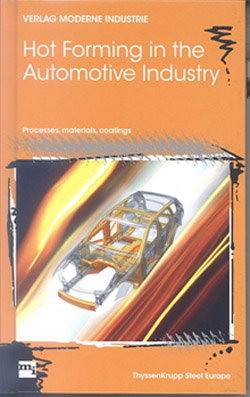
Hot Press Forming in the Automotive Industry
This book was originally written in German by the authors from Thyssen-Krupp Steel Europe AG. and was translated into English following the success of the German edition. In this book the substance and development of hot press forming is described with particular emphasis on the automotive industry. Finally, a future outlook of hot forming technology is also given.
Authors: Banik, J., Gerber, T., Horstmann, J., Lenze, F. J., Liesner, J., Middelhauve, O., Mura, J., Sikora, S., Diaz, N. V.
ISBN: 978-3-86236-041-3
Publisher: Süddeutscher Verlag onpact GmbH
Year: 2013
About this Book
This book as a short excellent summary on recent hot forming activities was originally written in German by the authors from Thyssen-Krupp Steel Europe AG. with the title “Warmumformung in Automobilbau“. The title of the English version is “Hot Forming in the Automotive Industry“. Both the English and the German versions are available at the following URL: http://www.sv-onpact.de.and was translated into English following the success of the German edition.
After a short introduction describing the substance and development of hot press forming particularly in the automotive industry a comprehensive overview of hot forming technology is followed with the materials developed primarily for hot press forming processes. Finally, a cost comparison and future outlook of hot forming technology is also given.
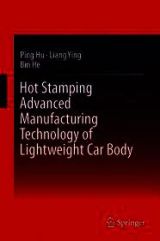
Hot Stamping Advanced Manufacturing Technology of Lightweight Car Body
This book summarizes the advanced manufacturing technology of original innovations in hot stamping of lightweight car body. A detailed description of the technical system and basic knowledge of sheet metal forming is given, which helps readers quickly understand the relevant knowledge in the field. Emphasis has been placed on the independently developed hot stamping process and equipment, which help describe the theoretical and experimental research on key problems involving stress field, thermal field and phase transformation field in hot stamping process. Also, a description of the formability at elevated temperature and the numerical simulation algorithms for high strength steel hot stamping is given in combination with the experiments. Finally, the book presents some application cases of hot stamping technology such as the lightweight car body design using hot stamping components and gradient hardness components, and the cooling design of the stamping tool.
Authors: Hu, Ping; Ying, Liang; He, Bin;
Publisher: Springer
Publishing date: 2016
ISBN:978-981-102-400-9
About this Book
This book is intended for researchers, engineers and graduate students in vehicle engineering, mechanical engineering, especially in the field of advanced manufacturing technology. The book also provides a useful reference for other new technology related temperature and phase transformation, such as aluminum-magnesium alloy hot stamping.
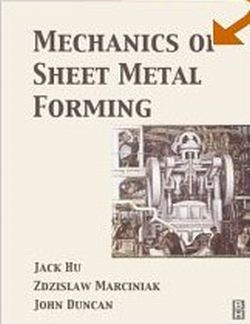
Mechanics of Sheet Metal Forming
Authors: Z. Marciniak, J. Duncan
Publisher: Edward Arnold
Year: 1992
In this book, the theory of engineering plasticity is applied to sheet metal forming processes. Bending, stretching and drawing of simple shapes are analyzed and, where possible, the limits governing each process are identified.
This is the first English text to gather together the mechanics of sheet metal forming in this manner, though it does, of course, draw on earlier work by Swift, Sachs, Fukui, Johnson, Mellor and Backofen.
It is intended for both students and practitioners and may also assist the researcher. This book may well serve as a teaching text and includes a number of exercises at the end. There are no references.

Physical Metallurgy for Engineer
Written by Prof. M. Tisza, this book should be a valuable reference for experienced metallurgists, mechanical engineers, and students seeking a practical technical introduction on metallurgy.
ISBN #: 0-87170-725-X
Pub. Date: 2001
Format: Hardbound
Publisher: ASM International
Pages: 402
This book should be a valuable reference for experienced metallurgists, mechanical engineers, and students seeking a practical technical introduction on metallurgy. Contents are based on lectures designed for undergraduate students in mechanical engineering, and the book is an excellent introduction on the fundamentals of applied metallurgy. The book also contains numerous graphs, tables, and explanations that can prove useful even for experienced metallurgist and researchers.
Contents cover both the fundamental and applied aspects of metallurgy. The first half of the book covers the basic principles of metallurgy, the behavior of crystalline materials, and the underlying materials concepts related to the mechanical properties of metals. The second half focuses on applied physical metallurgy. This includes coverage on the metallurgy of common alloys systems such as carbon steels, alloyed steels, cast iron, and nonferrous alloys.
Contents
1. Introduction to Physical Metallurgy
2. The Atomic Structure of Materials
3. Fundamentals of Crystal Structure
4. Basic Rules of Crystallization
5. Imperfections in Crystalline Solids
6. Mechanical Properties of Single-Phase Metallic Materials
7. Metallic Alloys
8. Equilibrium Crystallization of Iron-Carbon Alloys
9. Non-Equilibrium Crystallization of Iron-Carbon Alloys
10. Plain Carbon Steels
11. Alloyed Steels
12. Cast Iron
13. Nonferrous Metals and Alloys
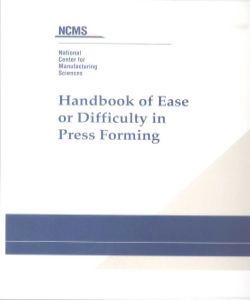
Handbook of Ease or Difficulty in Press Forming
Publisher: The Thin Sheet Steel Forming Technology Study Association
Ordering Address: National Center for ManuFacturing Sciences, 3025 BoardwalkAnn Arbor MI 48108 USA
This handbook presents a compilation of the technologies and advancements that have been developed over the past 30 years in press forming technology. The study includes the identification of a technology for the future development of press forming technology. It also examines the development of press forming technology as a joint effort in the two technological fields of processing technology and materials manufacturing technology, and as a joint effort that spans two industries, namely the automotive industry, and the steel industry.
Contents
Chapter 1: The Concept of Evaluation of Ease or Difficulty of Forming
Chapter 2: The Limits of Break-type Forming and the Evaluation of Ease or Difficulty of Forming
Chapter 3: Defects in Surface Precision and The Evaluation of Ease or Difficulty of Forming
Chapter 4: Dimensional Precision Required and the Evaluation of Ease or Difficulty of Forming
Chapter 5: Surface Damage during Press Forming
Chapter 6: Tensile Rigidity and Dent Characteristics of Automobile Parts
Chapter 7: Essential Technologies in Press Forming of Automobile Parts
Chapter 8: Formability of This Steel Sheets and Formability Testing Methods
Chapter 9: Steel Sheets for Automobiles
Introduction to Materials Sciences
Publisher: University Publisher, Miskolc
Year: 2003
Ordering Address: University Bookshop University of Miskolc, 3515 Miskolc-Egyetemaros HUNGARY
This book is mainly intended for students in mechanical engineering, but it may also serve well for practising engineers as a practical technical introduction to materials science. Contents are based on lectures of the author held for undergraduate students in mechanical engineering. The book also contains numerous graphs, tables, and explanations that can prove useful even for experienced matrial scientists and researchers. Contents cover both the fundamental and applied aspects of materials science. The first half of the book covers the basic principles of materials science, the behavior of crystalline materials, and the underlying materials concepts related to the mechanical properties of materials. The second half focuses on applied materials science. This includes coverage of the common alloys systems such as carbon steels, alloyed steels, cast iron, and nonferrous alloys.
Contents include
Introduction to Physical Metallurgy
The Atomic Structure of Materials
Fundamentals of Crystal Structure
Basic Rules of Crystallization
Imperfections in Crystalline Solids
Mechanical Properties of Single-Phase Materials
Metallic Alloys
Equilibrium and Non-equilibrium Crystallization of Iron-Carbon Alloys
Plain Carbon Steels
Alloyed Steels
Cast Iron
Nonferrous Metals and Alloys.

Sheet Metal Forming
Publisher: IOP Publishing Ltd.
Year: 1992
The author takes the format of the IDDRG Working Groups as the foundation on which to build his book.
- In Part 1 – Processes – sheet metal forming is examined from a mechanical engineering viewpoint, firstly plasticity and anisotropy, then overlaying these with process variables such as friction, lubrication, temperature and the like and concluding with practical aspects of formingthe press-shop and associated problem solving.
- In Part 2 – Materials – the main sheet alloys are dealt with at varying lengths, depending on their industrial popularity.
- In Part 3 – Tests – those which are currently popular are described and discussed and their usefulness and shortcomings high-lighted.

Formability: A review of parameters and processes that control, limit or enhance the formability of sheet metal
This book (written by Wilko C. Emmens a well known expert in sheet metal forming) is about sheet metal formability: the ability to be formed into a desired shape. It tries to answer the question: is formability a material property in the strict sense?
Author: Wilko C. Emmens
ISBN: 978-3-642-21903-0
Pub. Date: 2011
Format: SofcoverSPringer
Pages: 112
Illustrations: 70
Contents
Chapter Two: Starting the problem
Chapter Three: Definition of formability
Chapter Four: The tensile test
Chapter Five: The Forming Limit Curve
Chapter Six: Bending
Chapter Seven: Non-straight strain path
Chapter Eight: Non-planar strress
Chapter Nine: Shear
Chapter Ten: Incremental forming
Chapter Eleven: Speed effects
Chapter Twelwe: Ultrasonic forming
Chapter Thirteen: Testing of formability
Chapter Fifteen: Back to the press shop
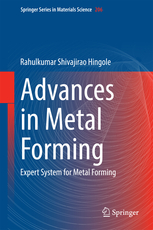
Advances in Metal Forming
Author: Hingole, Rahulkumar Shivajirao
Published by Springer Series in Materials Science
Year: 2015
ISBN 978-3-662-44497-9
About this book
This comprehensive book offers a clear account of the theory and applications of advanced metal forming. It provides a detailed discussion of specific forming processes, such as deep drawing, rolling, bending extrusion and stamping. The author highlights recent developments of metal forming technologies and explains sound, new and powerful expert system techniques for solving advanced engineering problems in metal forming. In addition, the basics of expert systems, their importance and applications to metal forming processes, computer-aided analysis of metalworking processes, formability analysis, mathematical modelling and case studies of individual processes are presented.
